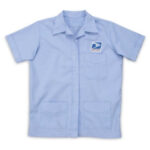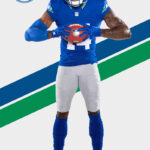While the American Revolutionary War Uniforms evoke images of tricorn hats and red coats, understanding the evolution of military attire brings us to the uniforms worn during World War II. This article delves into the details of the European and Pacific Theater uniforms used by US troops in WWII, highlighting the practicality and design considerations for different combat environments.
European Theater of Operations: Uniform Adaptations for Temperate Climates
The uniforms designed for the European Theater of Operations (ETO) prioritized warmth and protection against the elements. Here’s a breakdown of the key components:
Field Jackets: Versatility in Design
Two primary field jacket versions were utilized: the M-1941 and the M-1943. The M-1943 Field Jacket, pictured below, became the standard, phasing out the earlier M-1941.
The M-1943 Field Jacket was crafted from a darker olive drab cotton-poplin, offering improved wind and water resistance compared to its predecessor. This single-breasted jacket featured concealed buttons for a streamlined silhouette and incorporated practical upgrades such as two interior pockets, a detachable hood for varied weather conditions, a cotton-poplin liner for added warmth, and an internal synching tie to customize the fit and retain body heat.
The M-1941 Field Jacket, in contrast, was an olive drab cotton-poplin windbreaker-style jacket lined with wool flannel for insulation. It featured a zipper closure, a roll collar, buttoned cuffs, and slanted front pockets. Its looser design and economical production made it a suitable replacement for the heavier service coat in field operations.
Overcoats and Service Shirts: Layers for Warmth
For colder conditions, soldiers were issued overcoats made of wool melton, a dense and thick fabric with a soft surface providing substantial warmth. Service shirts, designed to be worn underneath, were button-up style in olive drab wool flannel, featuring two breast pockets and adjustable cuffs. The collar was designed to accommodate a necktie, reflecting a degree of formality even in service wear.
Trousers: From Wool Serge to Cotton Poplin
P1937 Trousers, constructed from olive drab wool serge, were standard issue for both service and field duty. These unlined trousers featured a button fly, diagonal side pockets, a single rear pocket, belt loops, and internal suspender buttons. Breeches, at this point, were largely relegated to mounted cavalry units, highlighting the shift in military tactics and equipment.
The M1943 Trousers, introduced mid-war, were made from a darker shade of olive drab cotton poplin and were unlined. These trousers incorporated adjustment tabs at the ankles and waist, allowing them to be worn over wool trousers in colder climates, demonstrating adaptability for changing weather conditions.
Leggings: Transitioning to Combat Boots
M1938 Leggings, made of khaki or olive drab cotton canvas, were initially paired with field service shoes. These leggings laced up the side and were secured with hooks, eyelets, and an instep strap. However, with the introduction of combat boots in 1943, leggings became obsolete. Puttees, which were leg wrappings used in earlier conflicts, were also phased out as trench warfare became less prevalent, reflecting the evolving nature of combat and uniform requirements.
Pacific Theater of Operations: Uniforms for Jungle and Tropical Environments
In the Pacific Theater of Operations (PTO), the US military adapted uniforms for the hot, humid jungle and tropical beach environments. Camouflage was first utilized by US troops in WWII in the Pacific, acknowledging the lessons learned from German camouflage use in Europe, although it was not widespread. Uniforms were designed to be reversible, featuring a green color scheme for jungle terrain and a tan color scheme for beaches, offering a degree of visual adaptation to the environment.
Jackets and Trousers: Herringbone Twill for Breathability
Jackets and Trousers for the Pacific theater were constructed from herringbone twill cotton. This olive drab cotton fabric was chosen for its breathability and quick-drying properties, crucial in humid climates, unlike the heavier wool used in European uniforms. The single-breasted jacket featured five buttons, two flap-secured breast pockets, and a roll collar designed to be worn open at the neck for ventilation. While primarily intended for jungle and desert combat, some herringbone twill jackets with added chemical protection were issued to troops involved in the Normandy Invasion, showcasing the adaptability of uniform components across theaters.
The herringbone twill trousers mirrored the jacket in material and practicality, featuring a button fly, belt loops, internal suspender buttons, and large flap-secured cargo pockets on each side for carrying essential equipment. The focus on lightweight, breathable, and quick-drying materials in the Pacific uniforms contrasted sharply with the emphasis on warmth and weather resistance in the European theater, highlighting the US military’s logistical and adaptive capabilities in tailoring uniforms to diverse combat environments.


